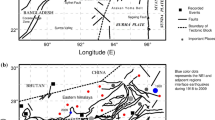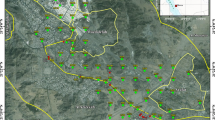Abstract
In the absence of an array of strong motion records, numerical and empirical methods are used to estimate the ground motion during 25th April 2015 Nepal earthquake. Spectral finite element method is used to simulate low frequency displacements. First, the simulated ground displacement is compared with the recorded data at Kathmandu. The good agreement between the comparisons validates the input source and medium parameters. The spatial variation of ground displacement is depicted through peak ground displacement and Ground residual displacement (GRD) contours near the epicentral region. The maximum GRD is of the order of 0.6 m in east–west, 1.8 m in north–south and 0.6 m in vertical (Z) direction respectively. Stochastic finite fault seismological model is used to simulate acceleration time histories. First, the seismological model is calibrated for the region with the available strong ground motion records at Kathmandu. The estimated stress drop for main-event and aftershocks lie in between 50 and 95 bars. Acceleration time histories are simulated at several stations near the epicentral region. Peak ground acceleration (PGA) and spectral acceleration (Sa) contour maps are provided. The estimated PGA near the epicentral region varies from 0.3 to 0.05 g. Another estimate of PGA for the main event is obtained from damage reports. The estimated PGA from simulations and damage reports are observed to be consistent with each other. The average amplification in the Indo-Gangetic plain is estimated to be in the order of 2–6. The simulated results from the study can be used as the basis for the possible ground motion behaviour for a future earthquake of comparable magnitude in the Himalayan region.













Similar content being viewed by others
References
Atkinson GM, Assatourians K, Boore DM, Campbell K, Motazedian D (2009) A guide to differences between stochastic point-source and stochastic finite-fault simulations. Bull Seismol Soc Am 99(6):3192–3201
Bilham R, Gaur VK, Molnar P (2001) Himalayan seismic hazard. Science (Washington) 293(5534):1442–1444
Boore DM (2009) Comparing stochastic point-source and finite-source ground-motion simulations: SMSIM and EXSIM. Bull Seismol Soc Am 99:3202–3216
Boore DM, Boatwright J (1984) Average body-wave radiation coefficients. Bull Seismol Soc Am 74:1615–1621
Chandler AM, Lam NTK, Tsang HH (2006) Near-surface attenuation modelling based on rock shear-wave velocity profile. Soil Dyn Earthq Eng 26(11):1004–1014
Chitrakar GR, Pandey MR (1986) Historical earthquakes of Nepal. Bull Geol Soc Nepal 4:7–8
Dunn JA, Auden JB, Ghosh AMN, Roy SC, Wadia DN (1939) The Bihar-Nepal earthquake of 1934, Mem. Geol Surv India 73:118–137
Field E, Jacob K (1993) The theoretical response of sedimentary layers to ambient seismic noise. Geophys Res Lett 20(24):2925–2928
GSI (2000) Seismotectonic Atlas of India and its environs. Geological Survey of India
IBC (2009) International building code. International Code Council, ICC
Iyengar RN, Raghukanth STG (2003) Attenuation of strong ground motion and site specific seismicity in Peninsular India. In: Proceedings of national seminar on seismic design of nuclear power plants, SERC, Chennai (Delhi: Allied Publishers Pvt. Ltd.), 21–22 February 2003, pp 269–291
Kayal JR (2008) Microearthquake seismology and seismotectonics of South Asia. Capital Publishing Company, New Delhi
Khattri KN (1987) Great earthquakes, seismicity gaps and potential for earthquake disaster along the Himalaya plate boundary. Tectonophysics 138(1):79–92
Komatitsch D, Tromp J (1999) Introduction to the spectral-element method for 3-D seismic wave propagation. Geophys J Int 139(3):806–822
Komatitsch D, Vilotte JP, Tromp J, and development team (2015) SPECFEM 3D cartesian user manual version 3. Pirnceton University, CNRS, University of Marseille and ETH Zürich
Lavé J, Yule D, Sapkota S, Basant K, Madden C, Attal M, Pandey R (2005) Evidence for a great Medieval earthquake (~1100 a.d.) in the central Himalayas. Nepal Sci 307(5713):1302–1305
Motazedian D, Atkinson GM (2005) Stochastic finite-fault modeling based on a dynamic corner frequency. Bull Seismol Soc Am 95(3):995–1010
Nakamura Y (1989) A method for dynamic characteristics estimation of subsurface using microtremor on the ground surface. Railw Tech Res Inst, Q Rep 30(1):25–33
NDMA (2011) Development of probabilistic seismic hazard map of India, a technical report of the working committee of experts (WCE) constituted by the National Disaster Management Authority (NDMA). Government of India, New Delhi
Patera AT (1984) A spectral element method for fluid dynamics: laminar flow in a channel expansion. J Comput Phys 54(3):468–488
Paudyal YR, Yatabe R, Bhandary NP, Dahal RK (2013) Basement topography of the Kathmandu Basin using microtremor observation. J Asian Earth Sci 62:627–637
Raghukanth STG, Somala SN (2009) Modeling of strong motion data in Northeastern India: Q, stress drop and site amplification. Bull Seismol Soc Am 99:705–725
Raghukanth STG, Lakshmi Kumari K, Kavitha B (2012) Estimation of ground motion during the 18th September 2011 Sikkim earthquake. Geomat Nat Hazards Risk 3(1):9–34
Saikat B, Raghukanth STG (2014) Effect of Indo-Gangetic plain on ground motion. In: Proceedings of the 5th Asia conference of earthquake engineering, Taipei, Taiwan, 16–18 October 2014
Singh SK, Garcia D, Pacheco JF, Valenzuela R, Bansal BK, Dattatrayam RS (2004) Q of the Indian Shield. Bull Seismol Soc Am 94(4):1564–1570
Srinagesh D, Singh SK, Chadha RK, Paul A, Suresh G, Ordaz M, Dattatrayam RS (2011) Amplification of seismic waves in the central Indo-Gangetic basin, India. Bull Seismol Soc Am 101(5):2231–2242
Upreti BN (1999) An overview of the stratigraphy and tectonics of the Nepal Himalaya. J Asian Earth Sci 17(5):577–606
Wald DJ, Quitoriano V, Heaton TH, Kanamori H (1999) Relationships between peak ground acceleration, peak ground velocity, and modified Mercalli intensity in California. Earthq Spectra 15(3):557–564
Yu G, Khattri KN, Anderson JG, Brune JN, Zeng Y (1995) Strong ground motion from the Uttarkashi, Himalaya, India, earthquake: comparison of observations with synthetics using the composite source model. Bull Seismol Soc Am 85(1):31–50
Author information
Authors and Affiliations
Corresponding author
Rights and permissions
About this article
Cite this article
Dhanya, J., Gade, M. & Raghukanth, S.T.G. Ground motion estimation during 25th April 2015 Nepal earthquake. Acta Geod Geophys 52, 69–93 (2017). https://doi.org/10.1007/s40328-016-0170-8
Received:
Accepted:
Published:
Issue Date:
DOI: https://doi.org/10.1007/s40328-016-0170-8




